10 Essential Elements in Modern Garden Design
When you approach modern garden design, you’ll quickly uncover that it’s about much more than just placing a few plants in the ground. There are ten essential elements that not only elevate the beauty of your space but also improve its functionality. From sustainable practices that support local ecosystems to thoughtful layouts that invite relaxation, each component plays a vital role. As you investigate these elements, you might find yourself reassessing your own outdoor space and wondering how to create a more harmonious and inviting atmosphere. What if the key lies in just a few strategic choices?
Sustainable Practices
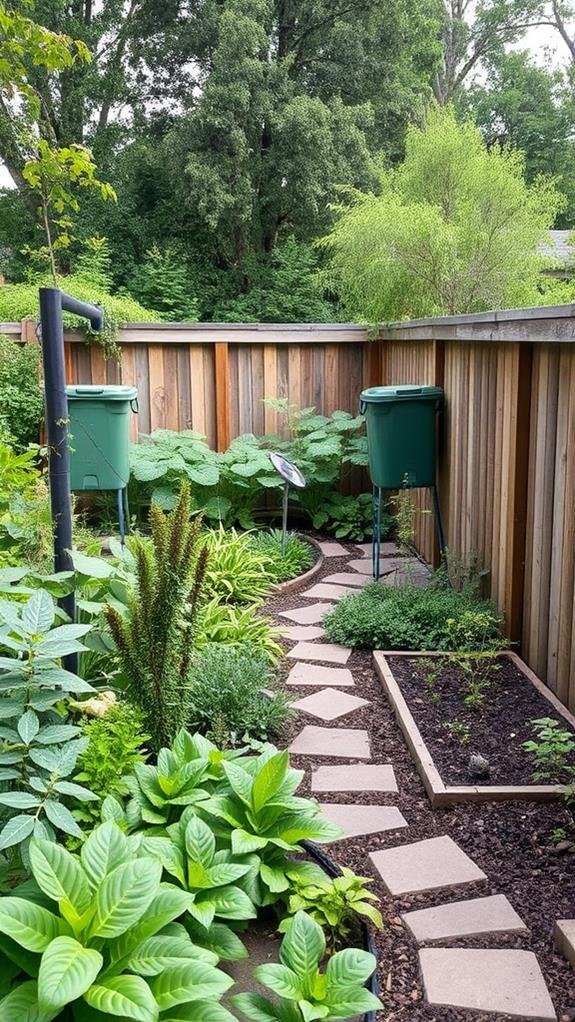
Sustainable practices are increasingly becoming essential in modern garden design. You can start by choosing native plants that thrive in your local climate, which reduces the need for extra water and chemicals.
Incorporating organic gardening methods, like composting and natural pest control, helps keep your garden healthy and eco-friendly.
Consider installing rain barrels to collect rainwater, providing a free resource for your plants. Also, try using mulch, as it conserves moisture and suppresses weeds.
Finally, incorporate hardscapes using recycled materials, giving your garden a unique touch while reducing waste.
Functional Layouts
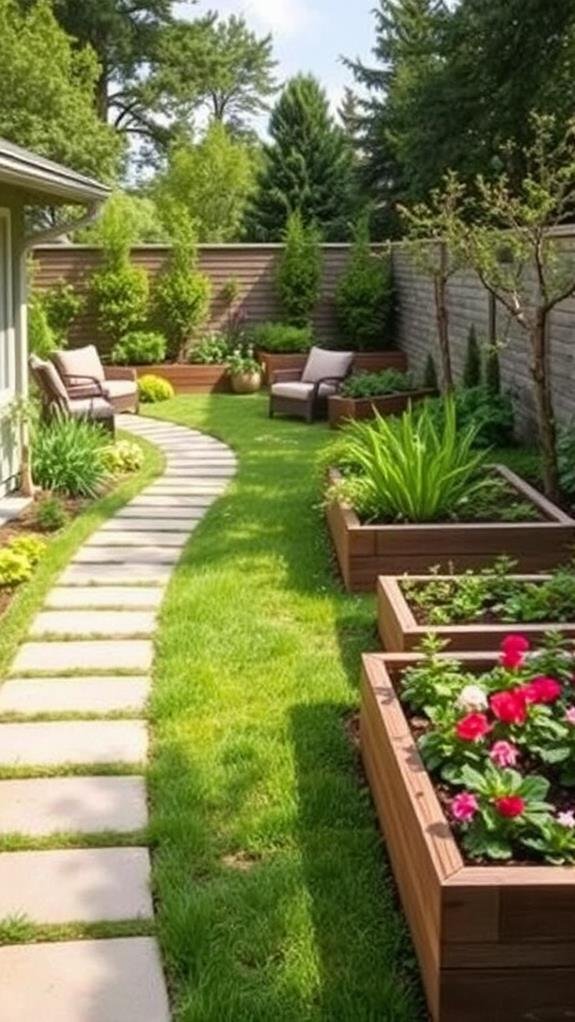
Creating a garden that’s not only beautiful but also practical starts with functional layouts. You want to think about how you’ll use your space daily.
Start by organizing areas for different activities, like lounging, dining, or gardening. Make sure paths are wide enough for easy movement, allowing you to reach plants without squishing them.
Consider sunlight and shade when placing seating or planting beds, as this will affect your garden’s usability. Incorporating raised beds or containers can also help with maintenance, keeping your plants accessible and organized.
Don’t forget about storage—adding a shed or themed storage can keep tools tidy and within easy reach. A functional layout lays the groundwork for a thriving garden you can enjoy year-round.
Plant Selection
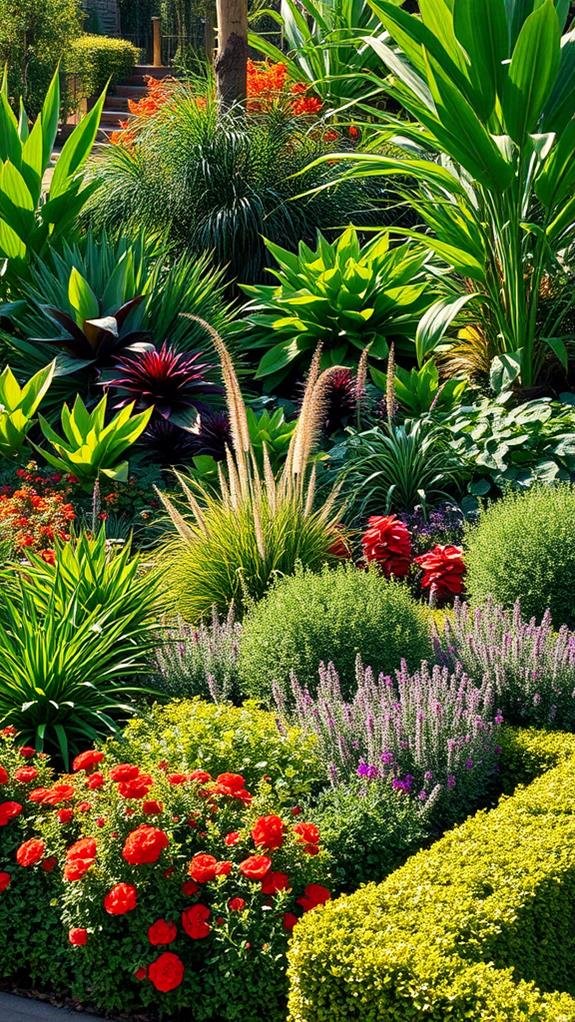
When choosing plants for your garden, consider the climate and soil conditions to guarantee they thrive.
First, check if you live in a dry, humid, or cold area. Knowing this helps you select plants that can handle the weather.
Next, test your soil to see if it’s sandy, clayey, or loamy. Different plants prefer different soil types, so this step is essential.
After that, think about the amount of sunlight your garden gets daily. Some plants love full sun, while others prefer shade.
Also, consider the size and shape of the plants, as they’ll affect your garden’s overall look.
Hardscaping Elements
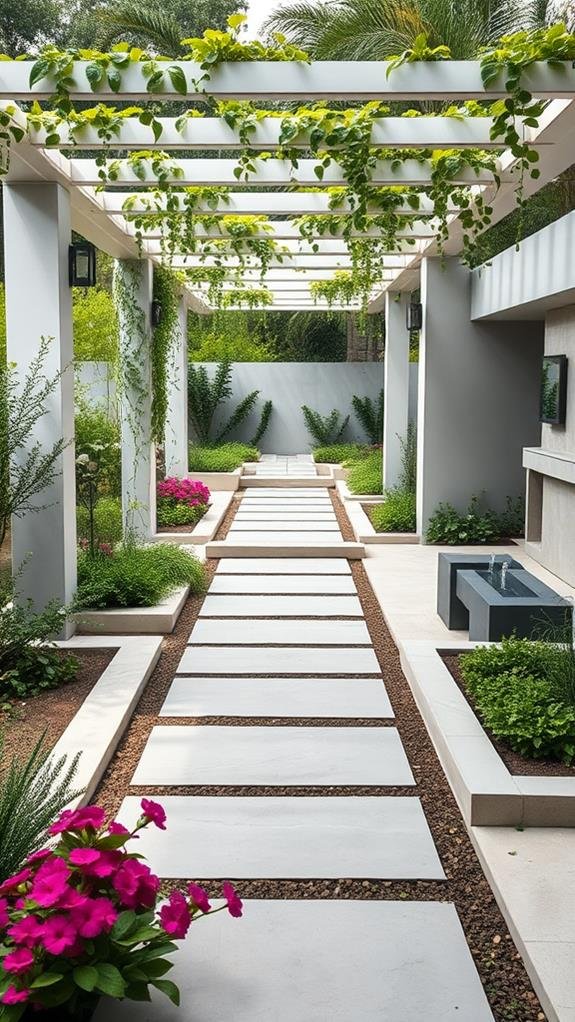
Hardscaping elements play an essential role in modern garden design, providing structure and functionality.
These non-plant features, like pathways, patios, and retaining walls, create a balanced outdoor space. When you incorporate hardscaping, you help define areas for relaxation or entertaining, making your garden more inviting.
Choose materials such as stone, brick, or concrete that complement your plants and overall design. Consider adding features like benches or fire pits for cozy gathering spots.
Proper layout improves flow and accessibility, ensuring everyone can move comfortably through your garden. Don’t forget about the importance of drainage; effective hardscaping can help prevent water issues.
Water Features
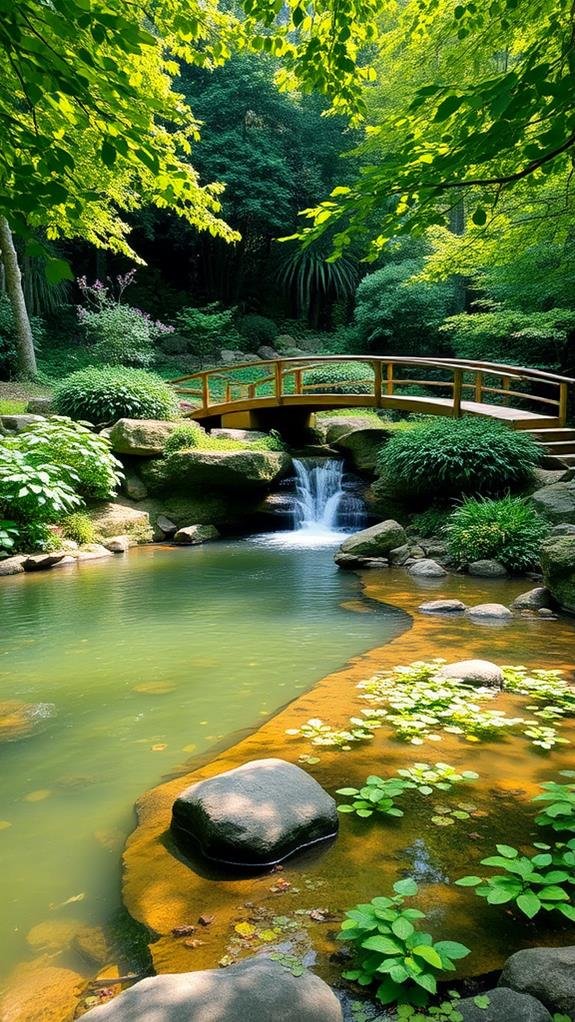
Water features add a dynamic element to modern garden design, enhancing the overall aesthetic while promoting a sense of tranquility. You can choose from a variety of options, such as fountains, ponds, or waterfalls, each providing a unique charm.
Fountains are great for small spaces, offering soothing sounds and striking visuals. If you have more room, a pond can create a habitat for fish and plants, enriching your garden’s ecosystem. Waterfalls add movement and enchantment, making your garden feel like a hidden oasis.
Incorporating these features not only enhances your landscape but also invites relaxation and mindfulness. Remember to contemplate safety and maintenance when selecting your water feature so you can enjoy its beauty without stress.
Lighting Design
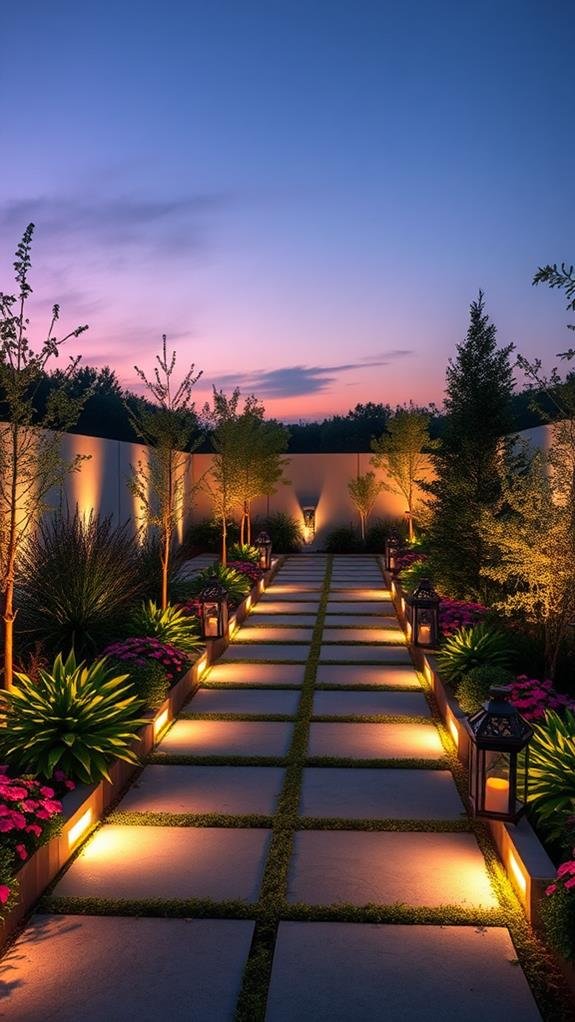
How can you transform your garden into a magical space after the sun sets?
With lighting design, you can create a warm and inviting atmosphere.
Begin by choosing the right types of lights. Pathway lights not only guide guests but also add charm.
Consider string lights draping over trees or fences for that cozy feel. For highlights, spotlights can illuminate your favorite plants or water features, making them the stars of your garden.
Don’t forget solar lights; they’re energy-efficient and require no wiring. You can also use lanterns to add a soft glow.
Outdoor Living Spaces
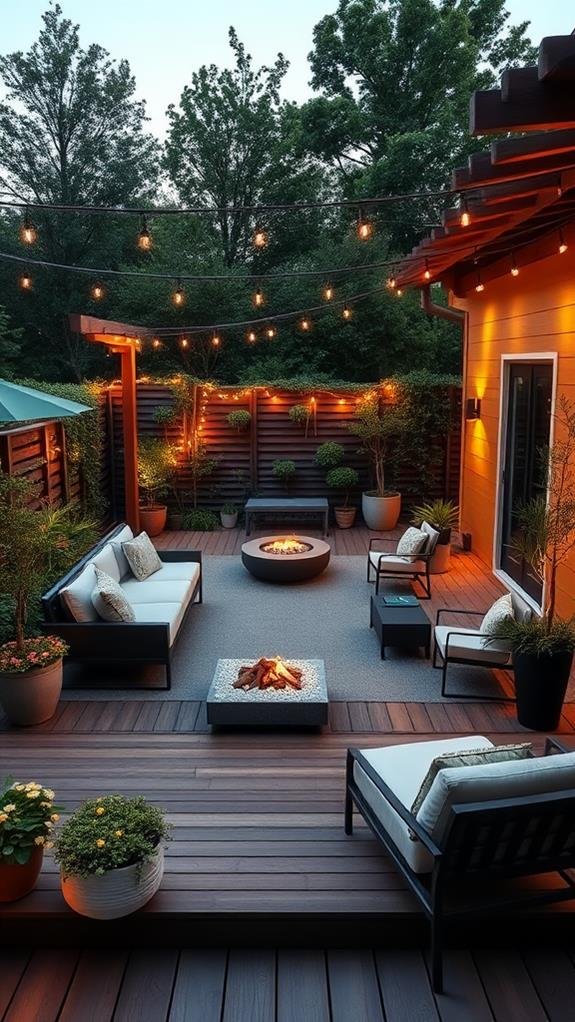
Creating inviting outdoor living spaces can greatly improve your garden experience. These areas provide a perfect spot for relaxation and socialization.
Think about adding a comfortable seating area with cushions and blankets, which makes your space cozy. A table can serve as a great centerpiece for meals or games with friends and family.
Don’t forget about shade; using umbrellas or pergolas can keep you cool during hot days. You might also consider incorporating outdoor kitchens or fire pits for added functionality and warmth during evenings.
Color Palette
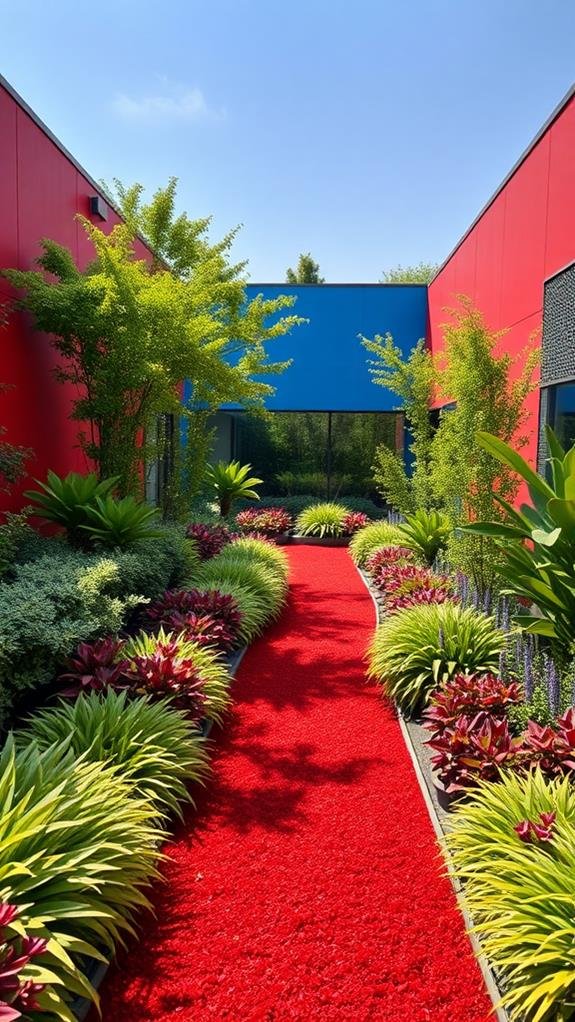
Choosing the right color palette can transform your garden into a stunning visual experience. When planning your garden, think about the colors you want to include. Bold colors like bright reds and yellows can create energy and excitement, while softer shades like pastels can bring calmness and harmony.
Consider how these colors interact with each other; complementary colors, like purple and yellow, can make your garden pop. You can also use various shades of a single color for a more subtle look.
Don’t forget to think about seasonal changes and how colors will appear throughout the year. Remember, your color choices should reflect your personal style and the mood you want to create, so have fun experimenting with different combinations!
Focal Points
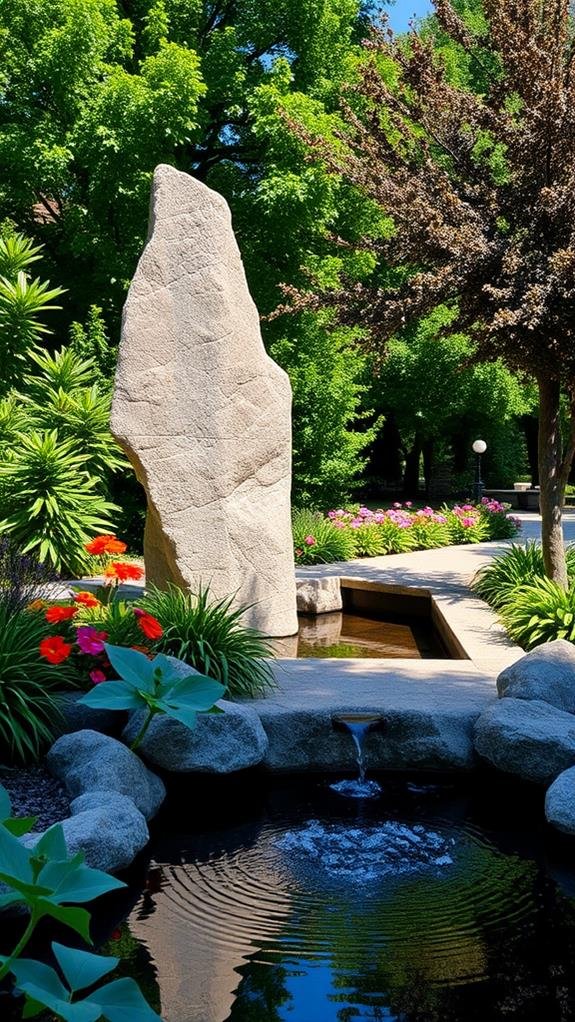
Incorporating a focal point in your garden not only enriches its aesthetic appeal but also draws the eye and creates a sense of structure. A well-placed feature, such as a beautiful sculpture, a vibrant flowerbed, or a striking tree, can capture attention and provide a theme for your garden design.
By selecting a focal point, you help guide visitors through your space, making it easier to navigate and enjoy. Consider the size, shape, and color of your focal point, ensuring it complements the surrounding elements.
You can even use multiple focal points to create layers of interest. Ultimately, these key features improve your garden, making it more inviting and visually engaging for everyone who steps inside.
Ecological Considerations
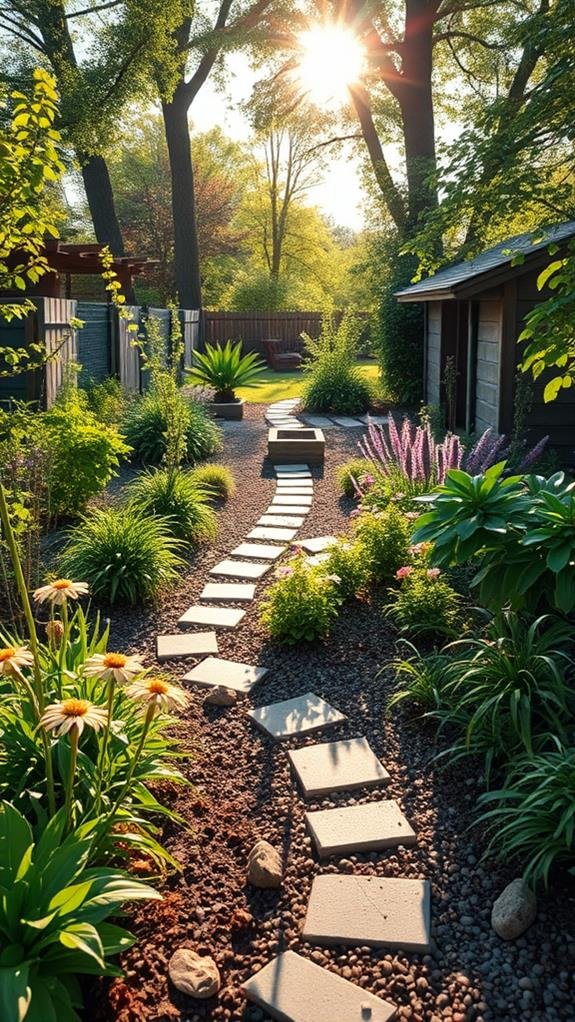
Often overlooked, ecological considerations play an essential role in modern garden design. When you plan your garden, think about native plants that thrive in your area. They require less water and attract local wildlife, creating a balanced ecosystem.
Consider using organic gardening methods to minimize harmful chemicals that can affect soil and water quality. You should also design your space with sustainable materials, reducing waste and energy use.
Incorporate features like rain gardens or permeable paving to manage water runoff and support biodiversity. Ultimately, don’t forget about creating habitats for beneficial insects and birds.
Conclusion
Incorporating these ten essential elements into your garden design can transform your outdoor space into a beautiful and functional oasis. By focusing on sustainability, creating a practical layout, and selecting the right plants, you’ll see how these choices make a big difference. Remember to add hardscaping, water features, and cozy living areas to elevate comfort and style. With attention to color and focal points, your garden can be both inviting and environmentally friendly—an outdoor retreat you’ll truly enjoy!
